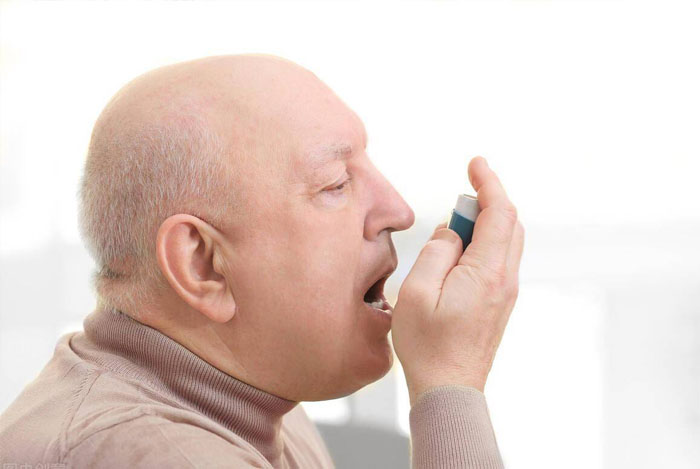- Login
- Cart{{shopingCartNum}}
- English
Asthma is a chronic lung condition that causes inflammation and narrowing of the airways, leading to difficulty breathing, chest tightness, coughing, and wheezing. These symptoms can range from mild to severe, and asthma is characterized by intermittent flare-ups known as "asthma attacks."

Asthma attacks often have identifiable triggers, which can be likened to uninvited guests sneaking onto the dance floor. These triggers may include:
1. Environmental factors:
Allergens: Many asthma patients are allergic to certain substances such as dust mites, pollen, animal dander (e.g., from cats or dogs), mold, and indoor/outdoor mold spores.
Air pollution: Smoke, exhaust fumes, ozone, and other air pollutants can also induce asthma symptoms.
Tobacco smoke: Both active and passive smoking can worsen asthma.
Climate changes: Cold air, humidity changes, and rapid weather changes can sometimes trigger asthma.
2. Emotional fluctuations: Strong emotional changes such as laughter, crying, or stress can also trigger asthma attacks.
3. Infections: Respiratory infections like colds and flu can particularly trigger asthma symptoms, especially in children.
4. Physical activity: Exercise-induced asthma refers to asthma attacks triggered by physical exertion, particularly in cold, dry environments.
5. Medications: Certain drugs can trigger asthma reactions, including aspirin, nonsteroidal anti-inflammatory drugs (such as ibuprofen), and beta-blockers.
6. Food and food additives: Food allergies (such as to nuts or shellfish) and certain food additives can also be triggers for asthma attacks.
Understanding and avoiding personal asthma triggers is an important aspect of managing asthma. Asthma patients should work with their doctors to develop a comprehensive asthma action plan, which typically includes identifying and minimizing triggers, monitoring breathing, and using appropriate medications when needed.

The symptoms of asthma can vary from person to person, but here are some of the most common signs:
1. Shortness of breath: Asthma sufferers may feel the need for increased effort in breathing, especially when taking deep breaths or exhaling air.
2. Wheezing: This is a sharp, high-pitched, or wheezing sound produced during breathing. Wheezing typically occurs during inhalation (breathing in) and/or exhalation (breathing out).
3. Coughing: This may be persistent or worsen only at night or in the early morning, or exacerbate after physical activity.
4. Chest tightness or pain: Asthma sufferers may experience a feeling of tightness or pressure in the chest, especially during severe asthma attacks.
5. Lack of energy or fatigue: Due to breathing difficulties, asthma sufferers may feel fatigued or unable to engage in normal daily activities.
6. Sleep problems: Nighttime or early morning asthma symptoms (such as coughing or shortness of breath) may lead to decreased sleep quality.
Asthma symptoms may not always be present. They may occur periodically and may worsen due to trigger events (such as exposure to allergens or a cold). Asthma patients should seek medical attention promptly when symptoms occur or worsen, and work with their doctor to develop or adjust their asthma management plan.

1. Medication: Asthma medications can be divided into two main categories:
- Long-term control medications: Used for daily scheduled use to maintain long-term control of asthma. Inhaled corticosteroids (e.g., fluticasone, budesonide), long-acting β2-agonists (LABAs, e.g., salmeterol, formoterol), leukotriene modifiers (such as montelukast), inhaled anticholinergics, biologics (targeting specific types of severe asthma).
- Quick-relief medications: Used to rapidly relieve acute asthma symptoms and asthma attacks. Short-acting β2-agonists (SABAs, e.g., albuterol, terbutaline), oral or intravenous corticosteroids.
2. Avoiding triggers: Understanding and avoiding triggers that can exacerbate asthma symptoms is crucial. Common triggers include allergens (such as dust mites, pollen, pet dander), air pollution, smoke, cold air, exercise, infections (such as colds), as well as stress and emotional changes.
3. Lifestyle changes: Quit smoking and avoid secondhand smoke and other irritating gases or particles. Maintain good physical health and strengthen respiratory muscles through appropriate exercise. Allergic asthma patients may require allergen immunotherapy.
4. Education and monitoring: Asthma patients should learn how to correctly use inhalers and/or nebulizers. Regularly monitor lung function and understand the level of asthma control. Learn to recognize early warning signs and symptoms of asthma to be able to address them promptly.
5. Regular check-ups: Maintain regular communication with the doctor and adjust the treatment plan based on the level of asthma control.
While asthma cannot be cured completely, with proper management and treatment, asthma patients can lead normal and active lives.

1. Avoiding triggers: Understand and avoid one's own asthma triggers, such as pollen, dust, pet dander, cold air, etc. Maintain good indoor air quality and avoid exposure to irritating chemicals.
2. Use of medication: Use prescribed asthma control medications and rescue medications as directed by the doctor. Control medications include inhaled corticosteroids and long-acting bronchodilators for long-term symptom control; rescue medications such as short-acting β2-agonists for emergency relief during acute asthma attacks.
3. Learn to use inhalation devices correctly: Learn to use inhalation devices (such as inhalers, nebulizers, etc.) correctly to ensure that the medication reaches the lungs. Have the doctor or nurse demonstrate the correct usage and regularly check the working condition of the inhalation devices.
4. Regular exercise: Moderate aerobic exercise can improve lung function and cardiovascular endurance, but be mindful to avoid vigorous exercise or exercising in heavily polluted environments. Use short-acting β2-agonists before exercise to prevent exercise-induced asthma symptoms.
5. Follow healthy dietary principles: Maintain a balanced and nutritious diet, increase intake of fresh fruits, vegetables, and whole grains. Avoid excessive intake of irritating foods or potential allergens.
6. Regular check-ups and consultation with the doctor: Attend regular follow-up visits and consult with the doctor to monitor the condition, adjust the treatment plan, and address any new symptoms or worsening conditions promptly.
7. Emergency preparedness: Understand emergency measures in case of urgent situations, how to use emergency medications correctly, and when to seek professional medical help.
Asthma patients should take comprehensive care measures, including avoiding triggers, using medications correctly, maintaining a healthy lifestyle, and consulting the doctor regularly to ensure good disease control and improve quality of life. Always follow the doctor's advice and seek professional help promptly when needed.
While asthma may bring some challenges to patients' lives, understanding the truth about asthma and mastering the correct treatment and management methods can effectively control asthma symptoms and improve quality of life.